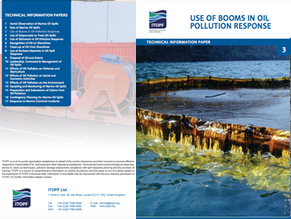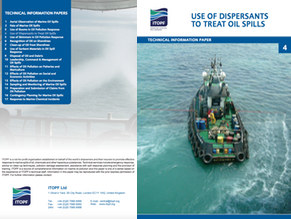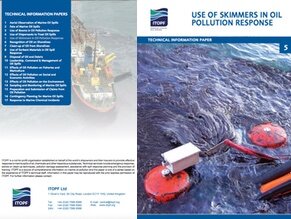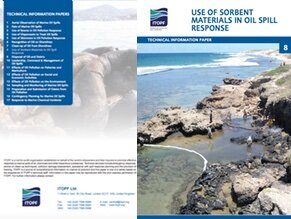Response Techniques
Once oil is spilled at sea, it will naturally spread, fragment and disperse under the influence of wind, waves and currents.
For spills in coastal waters, the oil will often drift towards the shore and become stranded due to the action of waves and tides. In order to contain the oil at the spill site, recover the oil floating on the sea and clean-up any oil that might become stranded on the shore, there are a variety of techniques that can be employed. The prevailing weather and sea conditions, the characteristics of the oiled shoreline and the nature of the oil can all combine to pose challenges to any clean-up operation.
At-Sea Response

Several options are available to respond to oil at sea and can be considered in three broad strategies; containment and recovery, in-situ burning and dispersant application. The selection of the most appropriate strategy will depend on many factors, including; the response resources available, the national and local regulations on oil spill response, the spill scenario and the physical and ecological characteristics of the area impacted by the spill.
Shoreline Clean-Up and Response

The majority of ship-source oil spills occur close to the coast and, as a result, many spills result in contamination of shorelines. Oil reaching stranding on the shore can cause significant environmental and economic impacts and may also largely determine the political and public perception of the scale of the incident, as well as the over costs.
When oil does reach the shoreline, considerable effort may be required to clean the affected areas. It is therefore essential that comprehensive and well-rehearsed arrangements for shoreline clean-up are included in contingency plans. The techniques available for shoreline clean-up are relatively straightforward and do not normally require specialised equipment. However, inappropriate techniques and poor organisation can aggravate the impacts caused by the oil itself.
Explore Documents on Response Techniques
01.기름오염 항공탐색 지침
항공탐색은 해상에서 작업선의 배치와 작업통제, 오염 가능성이 있는 해안선의 시기적절한 보호, 해안방제 자원의 준비를 위한 정보를 제공한다. 이 문서는 효과적인 항공탐색을 수행하기 위한 조언과 지침을 제공한다.
Categories: Fate of Oil Spills, Response Techniques, Planning & operations, Spill Response, Technical Information Paper (TIPS)
03.기름오염방제시 오일펜스 사용지침
본 문서에서는 오일펜스의 설계 원칙과 두 가지 사용 방식, 구체적으로 해상에서의 선박을 이용한 예인 방식과 천해 또는 연안에서의 고정 방식에 대해 설명한다.
Categories: Response Techniques, Containment & Recovery, Planning & operations, Technical Information Paper (TIPS)
04.기름오염방제시 유처리제 사용지침
본 문서에서는 선박을 이용한 기름 유출 방제 수단의 하나로서 유처리제의 사용 및 한계에 대해 개괄한다.
Categories: Response Techniques, Dispersants, Technical Information Paper (TIPS)
05.기름오염방제시 유회수기 사용지침
본 문서에서는 기름 유출 사고 시 유회수기의 효과적인 사용에 필요한 기본 요건에 대해 설명한다. 본 문서의 내용은 특히 오일펜스의 사용, 해안방제 기법 및 수거기름 처리에 관한 ITOPF 방제기술 정보문서들과 연관지어 이해해야 한다.
Categories: Response Techniques, Containment & Recovery, Planning & operations, Technical Information Paper (TIPS)
06.해안오염 식별지침
대규모 기름 유출의 경우에는 해안 부착유의 유출원은 명백하나, 적은 양의 기름 유출 사고로 피해 및 방제비용에 대한 보상 문제가 발생할 경우, 유출원을 식별해야하는 문제가 빈번히 발생한다. 이 문서의 목적은 서로 다른 해안선에 대해 유출유의 종류와 양을 식별하도록 돕는 데 있다.
Categories: Response Techniques, Planning & operations, Technical Information Paper (TIPS)
07.해안방제 지침
본 문서는 일반적으로 이용되는 해안 방제기술과 다양한 해안 특성을 고려하여 단계별로 가장 적절한
방제방법을 제안한다.
Categories: Response Techniques, Technical Information Paper (TIPS)
08.기름오염방제시 유흡착재 사용지침
본 문서에서는 사용 가능한 유흡착재의 종류 및 방제 과정에서의 효과적인 사용법에 대해 검토한다. 본 문서는 다른 ITOPF 문서 시리즈, 특히 오일붐의 사용, 유회수기의 사용, 해안가 정화 기법, 기름과 쓰레기의 처리 등에 대한 문서들과 관련지어 이해해야 한다.
Categories: Response Techniques, Technical Information Paper (TIPS)







